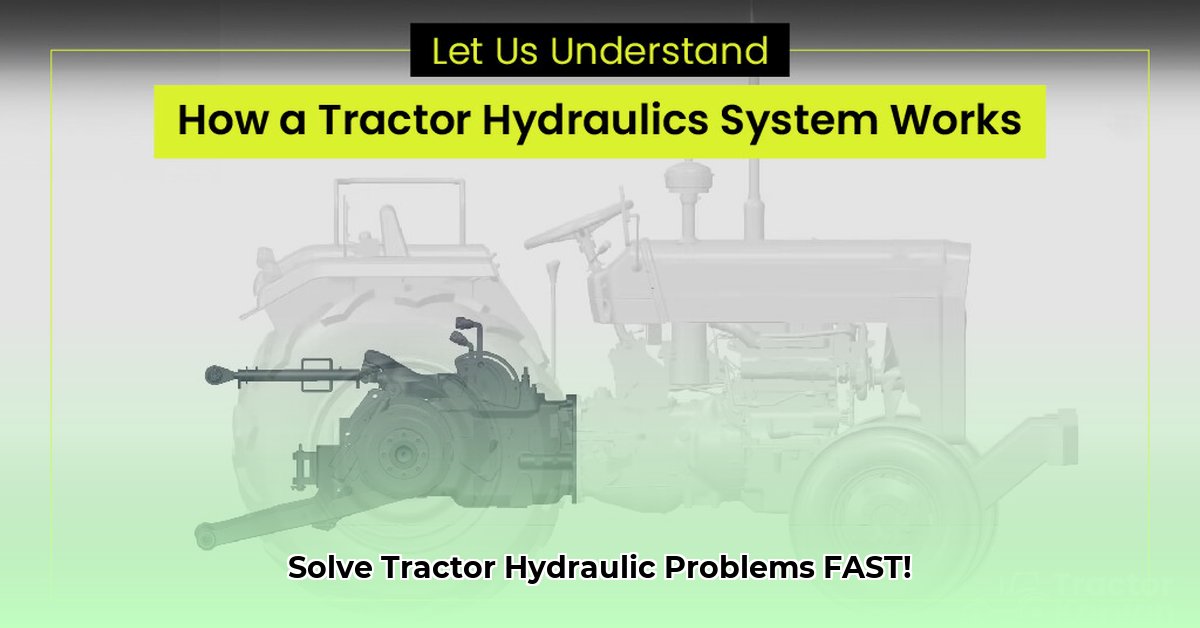
Understanding your tractor's hydraulic system is crucial for efficient operation and effective troubleshooting. This guide will demystify tractor hydraulic system diagrams, enabling you to diagnose and fix problems, ensuring your tractor runs smoothly. We'll cover basic components, system types, diagram interpretation, troubleshooting, and preventative maintenance. For more in-depth troubleshooting, check out this helpful resource: John Deere Hydraulics.
Understanding the Hydraulic System's Building Blocks
Before delving into diagrams, let's familiarize ourselves with the core components. A tractor's hydraulic system uses pressurized fluid (typically oil) to generate power for various functions like lifting implements or powering the steering.
- Hydraulic Pump: This component pressurizes the hydraulic fluid, acting as the system's heart. It's akin to the engine of your hydraulic circuit.
- Valves: These control fluid flow, directing it to different actuators (cylinders or motors) and regulating pressure. They act as the system's control centers.
- Cylinders (Actuators): These convert hydraulic pressure into linear movement, such as raising or lowering a loader arm. They are the system's "muscles."
- Hydraulic Motors: These convert hydraulic pressure into rotary motion, such as powering a rotary tiller.
- Hydraulic Tank (Reservoir): This stores the hydraulic fluid when it's not being used. It's the system's storage container.
The entire system works like a highly controlled plumbing system, but with oil under pressure instead of water.
Open vs. Closed Center Systems: Key Differences
Tractor hydraulic systems are primarily of two types:
- Open-Center System: In this simpler system, when a valve isn't directing oil to an actuator, the oil flows back to the tank through gravity. This is similar to a garden hose where water returns to the source when the tap is turned off.
- Closed-Center System: In this setup, the oil remains under pressure even when no actuators are in use. This allows for more precise and responsive control. Imagine a pressure cooker where the pressure is always ready for application.
A system diagram clearly indicates which type is used in your tractor. Understanding this difference is critical for effective troubleshooting. Did you know that closed-center systems offer improved responsiveness compared to open-center systems?
Decoding Tractor Hydraulic System Diagrams: A Step-by-Step Approach
Reading hydraulic diagrams may seem daunting initially, but with a structured approach, it becomes manageable.
Step 1: Identify Key Components: Locate the pump, valves, cylinders/motors, and the tank. Each is represented by a symbol; refer to the diagram's legend for identification.
Step 2: Trace Fluid Flow: Follow the lines representing oil flow paths. Arrows show the fluid's direction, illustrating how it moves from the pump, through the valves, and to the actuators.
Step 3: Understand Valve Functions: Pay close attention to the valves. They control fluid flow and pressure. Different symbols represent different functions such as direction control, flow control, and pressure control. Their logic is key to understanding the system.
Step 4: Master the Symbols: Each symbol represents a specific component. Use the diagram's legend to familiarize yourself with them. Regular practice with different diagrams improves your understanding and proficiency.
Step 5: Visualize the Whole System: After tracing the oil flow and understanding valve functions, you'll visualize how the entire system works together, enabling you to predict outcomes and diagnose issues effectively. Visualizing the system as a whole is crucial for efficient troubleshooting.
Troubleshooting: Using Your Diagram to Pinpoint Problems
Hydraulic system malfunctions are common. Leaks are often the culprit. Your diagram helps pinpoint leak locations by tracing the oil flow path. Low pressure? Check the pump. No movement? The valve or cylinder may be the issue. The diagram helps narrow down possibilities.
Preventative Maintenance: Keeping Your System Running Smoothly
Regular maintenance is crucial. This includes checking oil levels, replacing filters promptly, and inspecting components for wear and tear. Preventative maintenance is far less expensive than major repairs. Use the diagram to systematically check each component, preventing small problems from becoming major headaches. Remember, proactive maintenance saves you time and money in the long run.
"Regular maintenance is the key to a long-lasting hydraulic system," says Dr. Emily Carter, Professor of Agricultural Engineering at Purdue University. "Preventative maintenance catches small problems before they become big, expensive repairs."
Diving Deeper (Optional): Advanced Hydraulic Components
More advanced systems incorporate components like pressure relief valves that protect the system from overpressure and flow control valves for finer control. More detailed diagrams will show these specialized components and their functionalities.
Conclusion
Mastering tractor hydraulic system diagrams empowers you to maintain and troubleshoot your tractor's hydraulic system efficiently. With consistent effort, you'll become proficient at interpreting these diagrams and resolving hydraulic issues confidently. Remember, these diagrams are valuable tools for keeping your tractor operational.